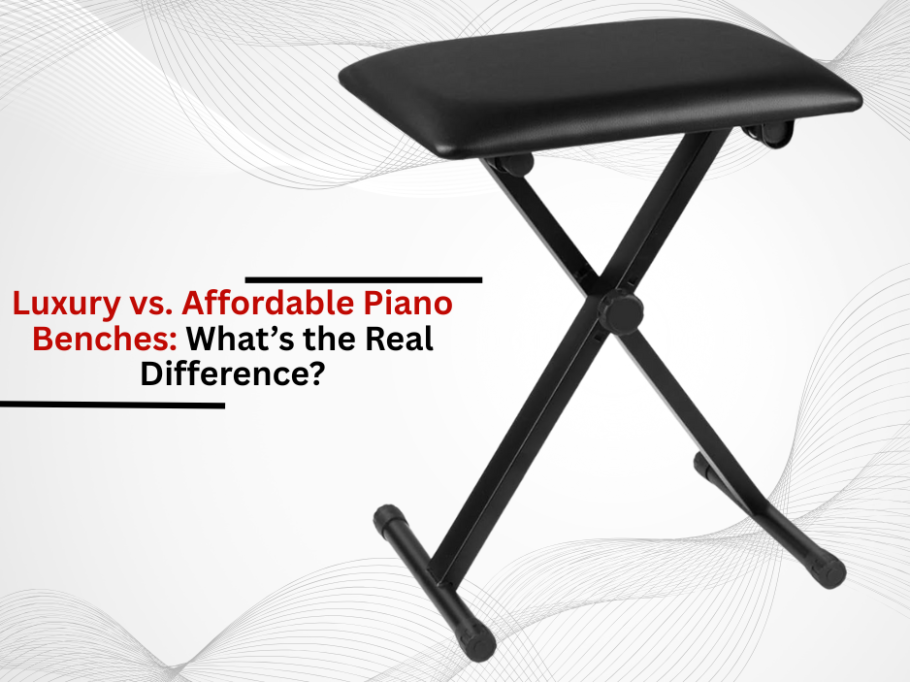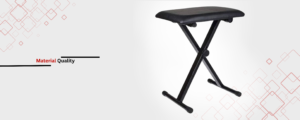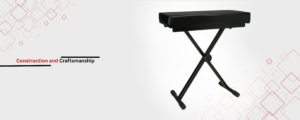A piano bench might not seem like an elegant accessory, but its craft, style, and materials can influence the comfort, posture, and biomechanics of playing a lot. Luxurious benches are known for their timeless artistic endeavor. Affordable boasts ease and practicality. Understanding the differences allows musicians to balance aspirations against needs, budgets, and plans.
To know more, read, Why a Good Piano Bench Matters More Than You Think
1. Quality of Material
The quality of materials used for piano benches impacts the aesthetics, functionality, and durability.
Luxury Benches:
Upper-end benches are made with the finest hardwoods like oak, walnut, and mahogany, while they are often finished with hand-polished lacquer or veneers. Upholstery includes top-grain leather alongside designer fabrics padded with high-resilience foam or memory foam. Metal components such as hinges or legs are made out of brushed steel or brass to prevent corrosion.
Affordable Benches:
Budget benches rely on cheap materials such as MDF or plywood. They also use PU or polyester-blended synthetic leather upholstery with standard foam padding. Although useful, these materials lack the aesthetic refinement commonly found in luxury alternatives.
2. Construction and Craftsmanship
The bendable partitions set affordable piano benches apart from luxury ones.
Luxury Benches:
As for the luxury models, artisanal mastery is a defining characteristic. Joints are reinforced using dovetail or mortise and tenon methods. Externally, custom-made stitching together with corner blocks ensures protection against fraying, while internally, they are hatched border stitched. Many of these benches are built to last decades and often come with extended warranties.
Affordable Benches:
Like their low-end counterparts, mass-produced benches do not skimp on screws, staples, or adhesive assembly methods. Basic mechanisms such as fixed spindle height adjustments are employed. The term affordable precisely describes these benches, as functionality takes preference to accuracy, which often leads to wobbling or loosening parts over time.
3. Comfort and Ergonomics
While comfort is essential for long hours of practice in a single position, it differs in approach between affordable and luxury benches.
Luxury Benches:
As for luxury models, every single piece of furniture includes astounding artisanal mastery. Joints are reinforced by custom stitching and corner blocks to protect from fraying, while internally it is hatched border stitched. Many of these are built to last decades and come with extended warranties. Unlike the affordable ergonomic benches, comfort is combined with craftsmanship.
Affordable Benches:
Seeing as inexpensive options and their low-end counterparts are almost identical, low-end is mass-produced with little to no comfort, sharp edges, staples, and screws. Basic mechanisms like fixed spindle height adjustments are employed. The term $200 bench is accurate, as these have very minimal effort while fulfilling the bare necessities.
4. Aesthetic and Design
More often than not, a bench’s price tier will reveal itself in its visual features.
Luxury Benches:
Every piece comes bespoke with bold and modern aesthetics or clear-cut polish. Custom-made color options and fine custom upholstery were also available. As statement pieces that are placed beside high-end pianos, these benches also serve as decor.
Affordable Benches:
Design aspects are basic or not included in order to cut costs. These strong benches lack appealing colors and finishes and instead feature neutral hues and basic outlines, serving a utility purpose. While aesthetically tolerable, these models are not appealing enough to be considered affordable or value luxury models.
5. Longevity and Maintenance
Different categories endure various levels of upkeep and maintenance, and the difference between luxury and affordable is stark.
Luxury Benches:
With proper care, these models last for generations, outliving any other model that becomes obsolete without consideration of maintenance. Hardwoods do not warp and are long-lasting, as well as high-quality upholstery that does not block stains or color fading. Clear maintenance entails occasional polishing or conditioning of leather, while more serious tasks demand professionals.
Affordable Benches:
In comparison to luxury, these benches will only endure 5-10 years of use, but that is to be expected with the price. Everyday use leads to cracking of materials like synthetic leather, so low-cost, easily cleaned but often replaced rather than repaired, affordable benches are tossed out.
Conclusion
The decision of whether to purchase luxury vs. affordable piano benches comes down to an individual’s lifestyle and value. Even though 5 Core, Roland, Donner, and K&M offer cost-effective and durable models, they also provide superior build quality in their premium lines. These brands appear to be paving a path towards greater imbalance between luxury and accessibility, but the future of piano benches may be reimagined using eco-friendly resources and sophisticated ergonomic design features. Regardless of the decision made, cultivating artistry ensures there is something tailored to every pianist’s preference.






